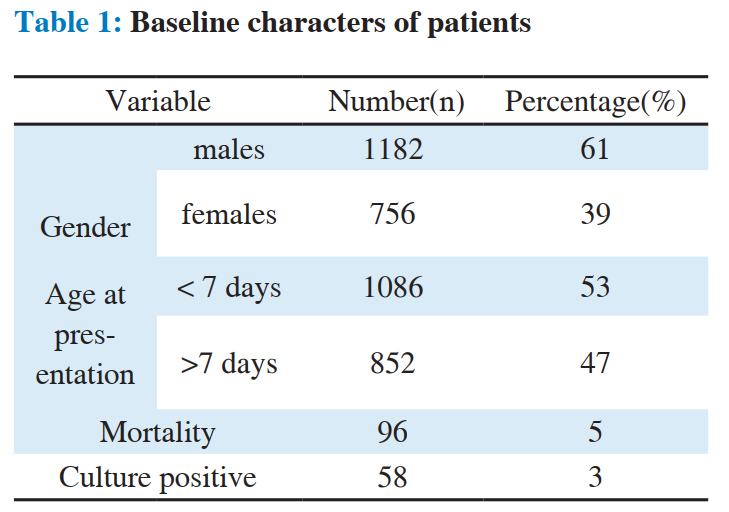Abstract
Background :
Neonatal sepsis is leading cause of mortality in neonates. The
organism responsible for sepsis differed depending on the site of Neonatal
care unit and country. In this study, we aimed to look at cause of sepsis and
antibiotic sensitivity.
Materials and Methods :
Neonates admitted in the
neonatal care unit of western regional hospital from 14th August 2012 to 14th
July 2014were included in the study. Septic workup was done and culture
was sent. Results of culture sensitivity were noted along with the sensitivity
pattern.
Results : Neonatal sepsis accounted for 38 percent of total admission
in the neonatal unit. Staphylococcus aureus was the most common organism
isolated which was followed by Escherichia coli (E coli). Staphylococcus
aureus isolated was sensitive to Cloxacillin in 97% of cases. There were 5
% mortalities during the study period.
Conclusion:
Neonatal sepsis was themost common reason for admission and staphylococcus aureus was the most
common organism.
References
who.int/gho/child_health/mortality/neonatal_text/en/
2. Anne R. Hansen ECE, Ann R et al.Cloherty and Stark’s Manual
of Neonatal Care 7th edition. 49: 624-5.
3. Wu JH, Chen CY, Tsao PN et al. Neonatal sepsis: a 6-year analysis in a neonatal care unit in Taiwan.Pediatrics and Neonatology.2009;50(3):88-95.
4. Plazek MM, White LA. Early and late neonatal septicemia. Arch
Dis Child. 1983;58:728–31
5. Shrestha P,D BK, Bhatta NK et al. Clinical and bacteriological
profiles of blood culture positive sepsis in newborns. J Nepal Paediatr Soc. 2008;27:64-7.
6. Sridhar PV TP, Sandeep M. Morbidity Pattern and Hospital Outcome of Neonates Admitted in a Tertiary Care Teaching Hospital,
Mandya. Int J Sci Stud. 2015;3(6):126-9.
7. Dias E, Viganeshwaran P, The bacterial profile of neoanatal septicemia in a rural hospital in south india, J Clin Diagnosis Res
2010,4:3327-30.
8. Shaw CK. Shaw P. Thapalial A. Neonatal sepsis bacterial isolates
and antibiotic susceptibility patterns at a NICU in a tertiary care
hospital in western Nepal, A Restrospective analysis. Kathmandu
Univ Med J 2008, 5:155-60
9. Bhattecharjee A, Sen MR, Prakash , Gaur A, Anupurba S Increased prevalence of extended spectrum beta lactamase producers in neonatal septicemic cases at tertiary referral hospital.
Indian J Med Microbio 2008, 26:356-60.
10. Shah AJ, Mulla SA, Revdiwalla SB, Neonatal Sepsis high antibiotic resiatance of the bacterial pathogens in a neonatal intensive
care unit of a tertiary referral hospital. J. Clin. Neonatal 2012,
1(2) 72-5.
11. Karthikeyan G PK.Neonatal Sepsis: Staphylococcus Aureus As
The Predominant Pathogen. Indian J Pediatr. 2001;68:715-7.
12. Thomas M PB, Srimathi G, Sundararajan V et al.Microbial Profile
Of Neonatal Infection In Coimbatore. Indian J Pediatr 1999;66:
11-4.
13. Seyal T HF, Anwar A.Audit of neonatal morbidity and mortality at neonatal unit of Sir Gangaram hospital Lahore. Annals of
KEMU. 2011 (17(1)):9-13.
14. MN. I. Situation of neonatal health in Bangladesh Orion medical
journal 2006; 6:8-10
15. A G , Factors predisposing to low birth weight in Jammu Hospital
South Western Ethiopia. East Afr Med J. 2005;82(11):554-8.

